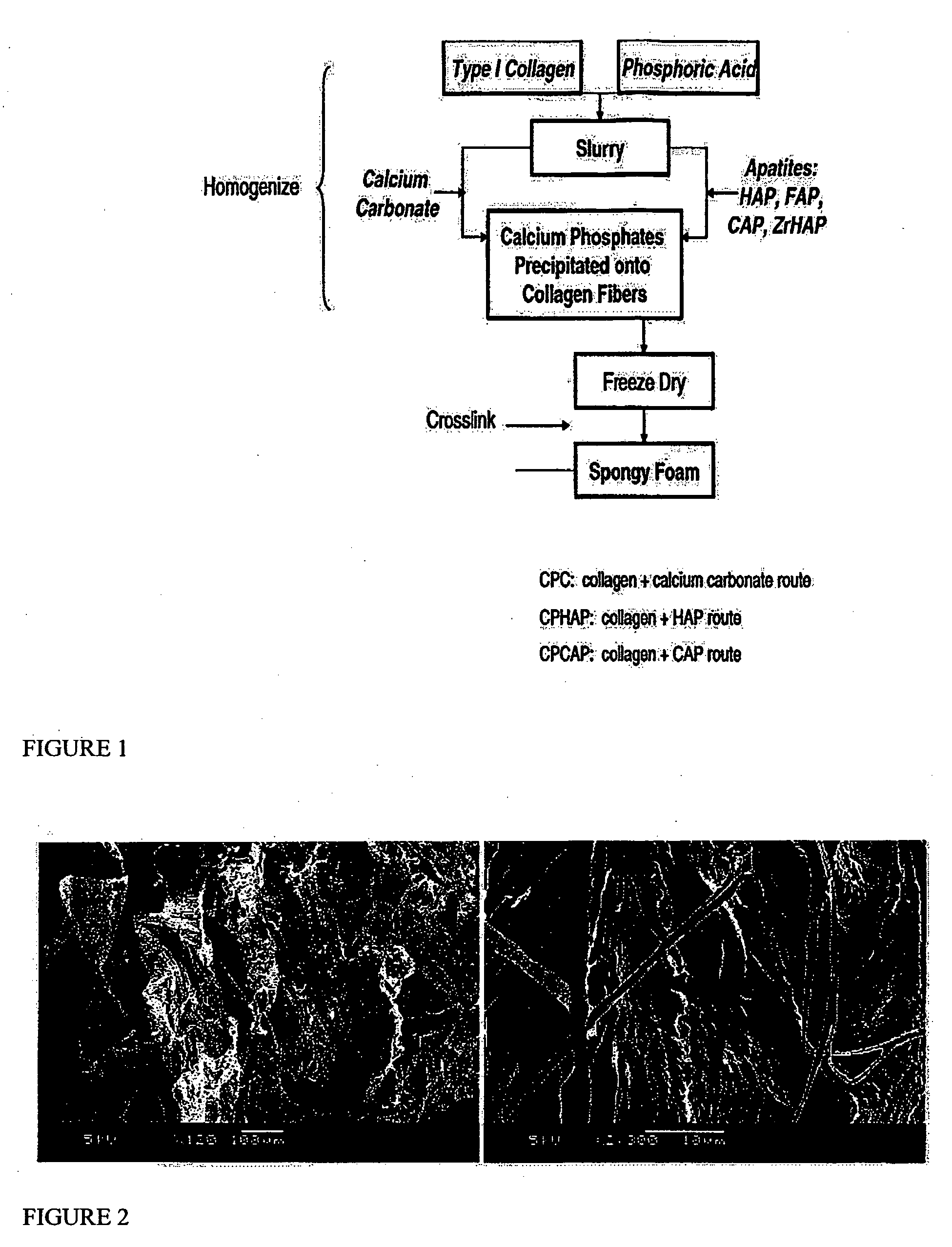Porous biomaterial-filler composite and method for making the same
- Summary
- Abstract
- Description
- Claims
- Application Information
AI Technical Summary
Benefits of technology
Problems solved by technology
Method used
Image
Examples
example a
[0134]The following example is a description of a method of preparing a hydroxyapatite which may be used in the present invention. The hydroxyapatite in this method is prepared by the sol-gel process.
[0135]The following starting materials were used:
Ca(NO3)2•4H2Omw = 236.15(NH4)2HPO4mw = 132.06
[0136]A first solution containing 0.05 M to 0.5 M calcium nitrate Ca(NO3)2.4 H2O in dH2O (deuterated water) was prepared. Separately a second solution containing 0.05 M to 0.5 M ammonium phosphate (NH4)2 HPO4 in dH2O was prepared to which was added a suitable amount of an ammonia solution NH4OH to adjust the pH of solution to about 10. The first solution was then added dropwise to the second solution. The solution was then aged for 100 hours at room temperature and a precipitate was then collected by centrifuging: The precipitate was then washed with three portions of decreasing concentrations of an ammonia solution NH4OH and dH2O, followed by two ethanol washes.
[0137]The resulting gel was air-...
example b
[0138]The following example is a description of a method of preparing a carbonated apatite which may be used in the present invention. The carbonated apatite in this method is prepared by the sol-gel process as follows.
[0139]The following starting materials were used:
Ca(NO3)2•4H2Omw = 236.15(NH4)2HPO4mw = 132.06(NH4)HCO3mw = 79.06
[0140]A first solution containing 0.05 M to 0.5 M calcium nitrate Ca(NO3)2.4 H2O in dH2O (deuterated water) was prepared. Separately a second solution containing 0.05 M to 0.5 M ammonium phosphate (NH4)2 HPO4, 0.05 M to 0.5 M ammonium carbonate (NH4)HCO3 and a suitable surfactant in dH2O was prepared. A suitable amount of an ammonia solution NH4OH was added to adjust the pH of the solution to about 10. The first solution was then added dropwise to the second solution. The solution was then aged for 100 hours at room temperature. A precipitate was then collected by centrifuging. The precipitate was then washed with three portions of decreasing concentrations...
example 1
[0142]FIG. 1 shows a schematic diagram for producing a scaffold in accordance with one embodiment of the present invention. In this embodiment Type 1 collagen is used such as shown in FIG. 2. FIG. 2 is a set of scanning electron micrographs of a dry collagen suitable for use in the present invention at resolutions of ×120 and ×2.3. The microstructure shows fibrils of approximately 1.5-2 μm in diameter mixed with thin filmy sheets.
[0143]As shown in FIG. 1, Type 1 collagen and phosphoric acid are combined into a slurry and homogenized and either calcium carbonate and / or an apatite (such as HAP, FAP, CAP, or ZrCAP) added to the slurry. The slurry is then homogenized whereby calcium phosphate and / or the apatite are interspersed and precipitated onto the collagen fibers.
[0144]The slurry is then freeze dried followed by cross-linking to form a spongy foam. The freeze-dried product may be crosslinked according to the following protocol:
[0145]1-ethyl-3-(3-dimethylaminopropyl)carbodiimide / N-...
PUM
| Property | Measurement | Unit |
|---|---|---|
| Grain size | aaaaa | aaaaa |
| Grain size | aaaaa | aaaaa |
| Mass | aaaaa | aaaaa |
Abstract
Description
Claims
Application Information
 Login to View More
Login to View More - R&D
- Intellectual Property
- Life Sciences
- Materials
- Tech Scout
- Unparalleled Data Quality
- Higher Quality Content
- 60% Fewer Hallucinations
Browse by: Latest US Patents, China's latest patents, Technical Efficacy Thesaurus, Application Domain, Technology Topic, Popular Technical Reports.
© 2025 PatSnap. All rights reserved.Legal|Privacy policy|Modern Slavery Act Transparency Statement|Sitemap|About US| Contact US: help@patsnap.com



